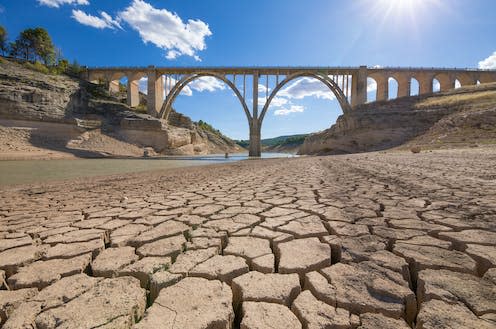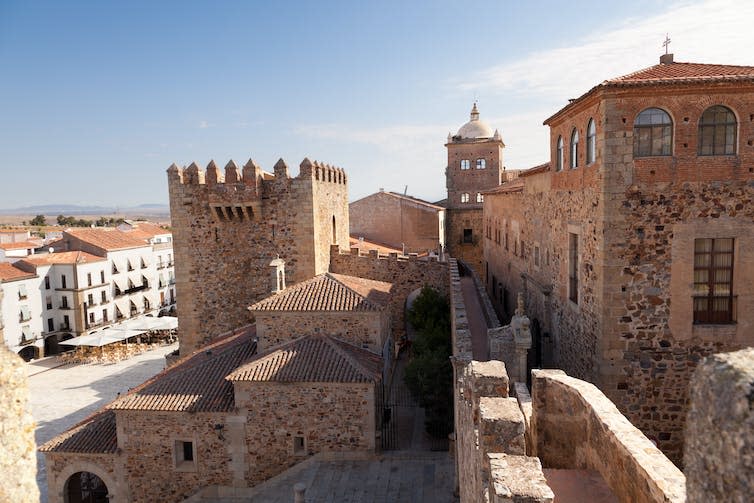Rural Spain could end up hosting infrastructure hubs for AI – here's what the environmental cost could be

While ChatGPT and other forms of artificial intelligence (AI) have been dominating headlines recently, little attention has been given to the physical infrastructure such as data centres and microchip factories needed to support this technological revolution. Debates surrounding AI are rarely concerned with how tech companies extract resources to fuel their growth.
Physical infrastructure supports the technology we use in everyday life. This includes data centres, large facilities that house the many computer servers needed to store the vast amounts of information accumulated by tech companies. It may also include mining operations to extract raw materials used as components in our technology, such as the lithium for batteries.
From the strawberries and coffee we buy in our supermarkets, to the jeans we wear and the laptops we work on, our material goods need land, water and human labour to be produced. When it comes to products that exist digitally this is no different.
Data centres need large amounts of water to provide a cool environment for the many computer servers they host. Lithium and copper are also key minerals needed to build microchips that are incorporated in computing units within data centres.
Rural treasures?
Between 1951 and 1990, the rural region of Extremadura in Spain lost 40% of its rural population and many of its jobs. However, the area is very rich in natural resources such as tin, gold and tungsten and in 2023 the region’s resources are attracting interest and in time these could deliver jobs and spark population growth. Lithium, which is found in the area, is a focus for boosting a green digital revolution in Europe, and providing new jobs.
The EU is encouraging the extraction of raw materials for this tech era within its borders in order to be less dependent on China and the US. In 2022, the EU imported €125 billion (£106 billion) of raw materials, while it exported €76 billion of materials – a trade deficit.
Australian company Infinity Lithium is planning to open a lithium mine in Extremadura. After promising jobs, and a sustainable and digital future based on new energies and an economic boost to rural Extremadura, the company is close to receiving approval from the Spanish government and local authorities.
Energy storage
However, this project is facing substantial resistance from citizens from the nearby city of Cáceres. A group called Salvemos la Montaña (“We Save The Mountain”) has been fighting against this project for five years. This group is concerned about the possible negative consequences for the environment and for human health.

Another company aiming to extract lithium from the region, Lithium Iberia, is promoting the idea of a green energy revolution in Extremadura. It proudly designates its own project as “the most sustainable mining operation in Europe”.
This company also plans to manufacture supercapacitors which will be used for storing energy. These supercapacitors can be used as a back-up source of power in regional data centres, if primary sources fail and to store and discharge power from wind and solar farms on less windy and less sunny days when they consequently supply less energy than usual.
Environmental threats
Data centres have been proposed as one solution for lifting Extremadura out of its difficult economic position. Politicians and companies have promised that jobs and economic wealth will come through digitalisation and projects will be labelled as sustainable.
However, data centres, even if they are sustainable, consume huge amounts of power to run computer servers. They also require vast quantities of water to cool them.
Facebook-owner Meta is planning to build a huge data centre in Castilla-La Mancha, another rural and de-populated region of Spain. The environmental impact assessment for the Castilla-La Mancha regional government showed that about six litres per second of water will be needed to cool the data centre. This is against the backdrop of one the most worrying droughts in years to hit Spain.
There are always concerns when big projects are located near populations of at-risk species because, for example, they might coincide with feeding or nesting sites for birds. There are relatively rare imperial eagles and black vultures in the region where Meta’s centre will be based. However, the assessments carried out for that project say no feeding sites or nests are located on the centre’s land, so no significant adverse effects are foreseen.
Resistance to data centres has not yet emerged in Extremadura, related to the the environmental impact of these facilities. Most of these projects are planned to be built within industrial parks and warehouses, which can sometimes mask their true environmental impact. For instance, Dutch media have claimed that a data centre in the Netherlands consumed more water than previously expected.

Extremadura highlights how the digital world has both visible and invisible effects on rural areas and land on the margins of cities. These effects can be both environmental and political.
In less populated areas, there will be fewer people and therefore resistance is likely to be weaker. Moreover, given the long legacy of socioeconomic struggles that these regions have suffered, local governments usually feel attracted to projects that promise economic wealth.
Many of the current debates about technology are centred on the potential effects of AI on society. Yet, the invisible impact of its digital infrastructure is usually neglected.
The specific industrial ecosystem that covers mining, data centres and green energy projects has a tangible and dramatic impact on deeply marginalised rural areas such as Extremadura and Castilla-La Mancha – even when they are sustainable.
In a world facing severe droughts and 2℃ of global warming, we need to question whether resource-intensive infrastructure to support the growth of advanced technologies such as AI is a viable solution for the long-term common good – what is referred to in Spanish as “el buen vivir”.
This article is republished from The Conversation under a Creative Commons license. Read the original article.

Ana Valdivia does not work for, consult, own shares from any company or organisation that would benefit from this article, and has disclosed no relevant affiliations beyond her academic appointment. She receives funding from The British Academy (project code: CZR01270) and the Dieter Schwarz foundation.


